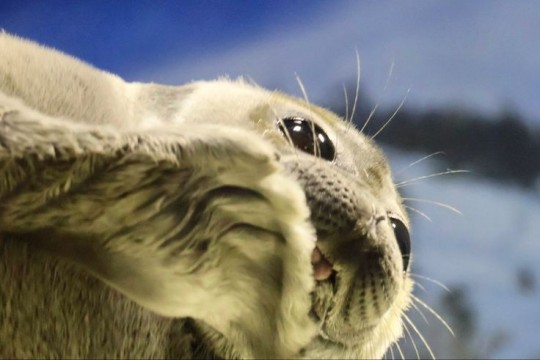Text
KNIGHT ETHNIC GROUPS, ORDERS AND CULTURES: A GUIDE
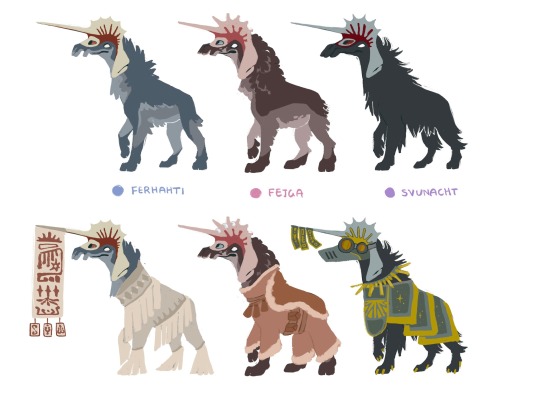
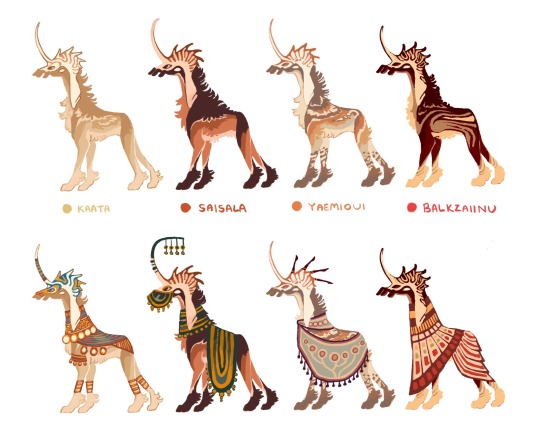
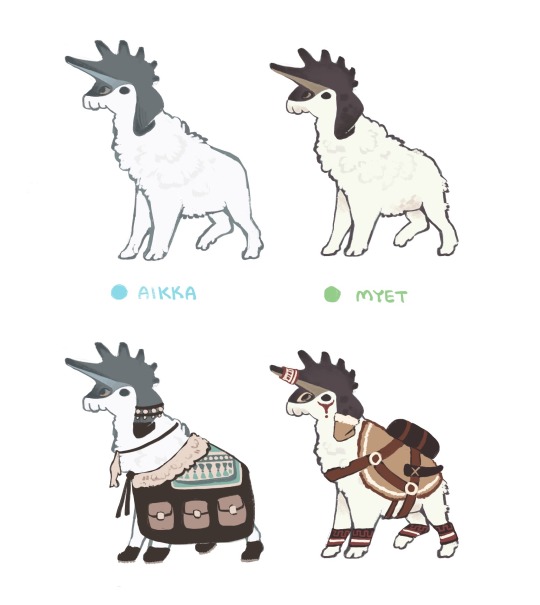
MAP OF ETTERA (Knight Homeplanet)

Standard map [continents shown]

Regional map [territories shown]
✦ ✦ ✦ ✦ ✦ ✦
I have here a weeks worth of writing and art because I for some reason enjoy torturing myself! I've been slaving away at this for so long but it's finally done and polished. So! As promised, I'm gonna talk a bit about the different Knight cultures/ethnicities, territories and general social structure.
Knights are one of my alien sophont civilisations from my Vivere 44 headworld. Here are more links from my previous posts:
Introductory post
Knight deities
Knight languages and names
With that being said, worldbuilding textwalls below the cut!
____
First, an explanation of the maps.
CONTINENTS
There are three main continents on Ettera. The two polar landmasses are Thannoeh in the northern end and Nahrui in the southern end. Thannoeh is divided by east and west, and is home to the two major Polar Knight nations. Nahrui is not occupied by any, aside from explorers or scientists. For many Knights, it is a strange, enigmatic land and a topic of great curiosity. In the middle is Val-srat; the central continent inhabited by Mountain and Plains Knights. The landmass is named as such because it is often represented in folklore as a Knight, with Valazear (the ‘Host’) being the southern Plains territories and Srati (the ‘Helmet’) being the northern Mountain territories. The Ihmna Stretch is the section of land connecting the two countries - ‘Ihmna’ is the Ferhahti word for the Integrator organ which joins the host and helmet’s consciousness.
Plant life on Ettera takes on hues of red and orange.
____
Before I get into the different ethnicities, I should elaborate more on how Knight Orders are structured and the different titles; some of the clothing articles are specific to status.
SOCIAL STRUCTURE
Most Knights live in groups called ‘Orders’, which I talked more about in this ask.
The standard roles for an Order are as follows:
Commander - Makes decisions, protects and supports the group. Commanders lead the Order across difficult terrain, plan out hunts, and take care of their members. A Commander might be chosen based on generational succession, experience, or strength. Depending on the rules of the Order, a Commander might be challenged by a Knight who desires their position, although only an elite or lieutenant would be permitted to do this. In more traditional and conservative orders Commanders are always Pike-forts.
Lieutenant - Second in command. The Lieutenant is the Commander’s primary advisor and runs the Order when they are unable to. A Commander may train their lieutenant to one day take their place as leader, or a lieutenant might serve multiple generations of Commanders without ever challenging them.
Elites - A selection of Knight soldiers who are exceptionally experienced, strong and fast. Highly respected by the rest of the Order and carry out important duties such as organisation. They have the highest chance of being the next lieutenant or Commander.
Soldiers - The main body of the Order, fully grown Knights who are proficient in all the skills necessary for survival. Soldiers are tasked with a variety of jobs to keep the Order healthy and running: they are also farmers, medics, entertainers, strategists, builders, etc.
Scouts - Scouts are Knights who make reconnaissance trips for the Order. Their job is to gather information about a potential area to settle or travel through. Scouts also have a range of other responsibilities, such as acting as lookouts, messengers, and taking care of Pages.
There are two types of Scouts - temporary and permanent. Temporary scouts are Squires (16-17 years) who have completed their training and are performing Expeditions, which they are required to do before becoming a full soldier. On Expeditions two or three Scouts will travel a certain distance away from the Order, sometimes miles away, to deliver goods to other Orders or to simply evaluate an area/route. Permanent scouts are lower-ranked Knights who are unable to become Soldiers, prefer a caretaker role, or have been relegated to the position.
Squires - Knights in training. Squires learn from a Soldier assigned to teach them. They may be tutored one-on-one, or taught in a group. They learn the ways of the Order and the world around them. Squires will often be assigned small hunting trips with their tutor, or cleaning jobs. Typically aged 7-15 years.
Pages - The youth of the Order, Knights aged 0-6 years. The pages are fiercely protected by every member of the Order. A newborn Helmet or Host will stay with their birth parent/s until they have assimilated, in which care duty is passed on to a permanent Scout. The Scout raises the Pages alongside several others until they are ready to become Squires.
This structure originated from Mountain Orders and spread to Plains and Polar regions a long time ago. Of course, not every Order follows this plan exactly, and there are countless variations. Some Knights don't live in Orders at all, and may live in pairs (which is common for travelling merchants and explorers) or small groups. Very rarely, a Knight may travel alone. This is the case for exiles.
____
You may already be familiar with the Mountain, Plains and Polar Knight regional varieties, but within these subspecies are various ethnic groups.
THE ETHNICITIES
✦ MOUNTAIN ✦
✦ Ferhahti [Ferhaht]
The Ferhahti Knights are an ethnic group located in the Ferhaht territory of Srati. Their thick fur is of various shades of grey and grey-blue. Their clothing styles are typically beige and tan, often complete with rectangular tassels and red accents. The Ferhahti have a ‘New Years’ festival called Khulaam in which they call upon Etteran spirits to bless them with good harvests, hunting and rain. During these festivals there is music, food, dancing and socialising with others. Allied Orders, usually 2-5, will come together to celebrate. Celebrations last five days. Alliances may be temporary or long-lasting, but the Orders will go on a hunt on the final day to bring down a large quarry. Oftentimes there will be a ‘Herald’ dancer who bears a flag on their horn, depicting glyphs of good fortune.
Since the Ferhahti and Kaata territories are neighbouring, and have no physical borders, Orders from both lands will often meet to trade goods and information. Many Plains-Mountain hybrids are of Ferhahti and Kaata descent due to the close proximity of the nations.
NOTE: Plains and Mountain Knights are capable of producing hybrid offspring, although they will be infertile. Neither Plains nor Mountain Knights can produce viable hybrids with Polar Knights.
✦ Fejga [Fejg]
Fejga Knights (pronounced Fej-ya) make their home in the Fejg archipelago. They are generally of a bulkier physique than other Mountain Knights, have a coat of thick fur and are well adjusted to chillier climates. They also sport a ‘saddle’ marking on their backs and are likely to have mottled/freckled patterns and blue eyes. Their Orders are partially seafaring, with many sailing from island to island in magnificent ships. Fishing is a large part of their lifestyles as the sea provides a stable source of food.
Their clothes are frequently made from leather and wool from domesticated animals. It is deceptively thin, as their pelts already provide natural insulation from the cold. Fejga Commanders wear three silver piercings on their Helmets.
✦ Svunacht [Svun]
Svunacht Knights live within the mountain-bordered territory of Svun and the island of Naahek. Orders have a special ceremony for choosing their Commander. The next in line, usually a chosen Host and Helmet born of the previous Commander and their partner, must journey across the Asall mountain range which borders Svun. It is a treacherous, long passage, and requires the Knight to wear a mask to block out the searing winds. They must also wear a spiked collar as a traditional accessory and safety measure to deter larger predators which roam the mountains. They are forbidden from carrying firearms, only armed with a knife, their wits, and natural defences. Ceremonial garments are required, passed down through generations, and three slips of fabric are worn on their horn for good luck: representing strength, wisdom and tenacity. The journey, called the Meha, is the final step in a long series of rigorous training for future successors.
The painting of Helmets is also a large part of Svunacht culture. It is typically only reserved for Commanders, Lieutenants or Elites.
★ PLAINS ★
★ Kaata [Kaat]
Kaata Knight Orders inhabit the deserts of Kaat. They are perfectly suited to desert life, their tan coats reducing heat absorbed from the sun. Kaata Knights make their clothing from woven fibres of plants that are garnished with gold pigments derived from a natural mineral found in the sands. They are especially known for their proficiency in fine crafts, and often trade jewellery to Ferhahti Orders across the Ihmna Stretch connecting Kaat and Ferhaht. Kaata clothing tends to be highly detailed and ornamental, with shiny beads adorning arm cuffs, necklaces, mandible rings and horn sleeves. The many gemstone and fossil deposits in Kaat are also incorporated into their styles. Like the Svunacht Knights, Kaata also paint their Helmets, although the practice is not restricted to any particular titles.
★ Saisala [Saisal]
Saisala Knights live in and around the deltas and rivers of Saisal, the southernmost territory of Val-srat. The area is filled with marshlands and everglades, and the weather is more wet and humid than the dry plains of Kaat. Saisala forts sport a dark reddish mane that grows right down their backs and bears some resemblance to maned wolves. Their pikes have hooked horns and sloping spines, as well as more ‘splotchy’ red stripes. Their Helmet eyes also have a pale ring around their pupils.
Saisala clothing styles are characterised by draping, ovular shapes and translucent sections of fabric. The green and gold drapes in the drawing are traditional wedding garments, complete with rounded tassels and a horn extension for pikes. The hanging ‘coins’ have engravings which tell a short but sweet poem.
★ Yaemioui [Yaemiou]
Yaemioui Orders live in a similar environment to Saisala Knights, in the wetland territories of Yaemiou. Their coats are pale like Kaata, but come in a greater combination of hues such as orange, grey and vermilion. Fun fact: all Plains Host pups are born with faint spots to help them camouflage, like lion cubs. Most lose these markings as they grow older, but Yaemioui hosts retain them even in adulthood. Their patterns are similar to painted dogs. The Yaemioui have a rich storytelling culture and have records dating back thousands of years.
Their clothing styles utilise dusky, non-bright colours that are usually two-piece. The outfit in the picture is worn by an elder Pike-fort who has carried and sired many offspring. The spine extensions are an indicator of age and experience, and a mark of high respect. The scarf around their neck depicts circles symbolising their Helmet children, and the circles on the larger cloth represent their Host progeny.
★ Balkzaiinu [Balkzaii]
On the island of Balkzaii reside the Balkzaiinu Knights, who have dark stripes on both their Hosts and Helmets and short curly fur. Unlike other Orders, Balkzaiinu communities rarely ever hunt - they were one of the first countries to develop farming and agriculture, and import a lot of domesticated animals to Saisal and Yaemiou. They are also the only country that has no Commanders in their Orders, and decisions are made by a council of higher-ups. They live in a tropical climate which receives lots of rainfall and cyclones. They are also masters in boat making and sailing, and contacted the mainland several centuries ago. Balkzaiinu have different decency standards than other Plains Knights, and in their culture it is considered proper to cover the neck area. Their clothing is generally layered and contains colourful, square designs.
✧ POLAR ✧
✧ Aikka [Ehtte Thannoeh]
Aikka Knights have domain over the Eastern section of Thannoeh. The polar word for East is Ehtte, and West Uesse. Since the country is so close to the Fegj archipelago, the two have been in contact for a long time.
Aikka have pristine white fur and a slightly bluish tinge to their Helmets. As with all Polar Knights, they are much smaller than their Plains or Mountain relatives, but are incredibly tough and hardy as a result of surviving in one of the harshest biomes. Ehtte Thannoeh is associated with scientific prowess, discovery and knowledge, and many famous Knight explorers are from Thannoeh. There are several research stations on Nahrui that are run and managed by Aikka; they have no difficulty working in the icy environment. Aikka Knights are also experts in carving, sculpting figurines and charms from the ivory tusks of marine animals. The outfit depicted in the drawing shows an Aikka Scout wearing a pendant with a carved basilosaurus-like animal for spiritual protection. These pendants are often given by parents to children. Their coat has six pockets for navigational instruments, goggles, knives, a spyglass, medical equipment and more.
✧ Myet [Uesse Thannoeh]
Myet Orders have less contact with other regions than Aikka. Residing in Uesse Thannoeh, Many of them live further inland. Myet Hosts have a more yellowish tinge to their fur and their Pike Helmets have a tan stripe. The Helmets also have a more rounded 'snout'. They have managed to domesticate a large predator which defends their camps and is used as a mount/companion. Like the Balkzaiinu, Myet Orders have a different structure than most, having two Commanders, usually a mated pair, and no lieutenants or elites.
Myet clothing is more minimal than Aikka styles. They usually cover the back with a ‘saddle’ and manipulators with gloves. The outfit drawn is of a Commander, distinguished by the ring of fabric around their horn and eye makeup. In their backpack they carry hunting weapons, and wear a knife sheathed at their side.
_________________
And that's a wrap! Thank you for reading, this project is truly a delight to work on. I leave you with some messy concept art I did a while ago for Mountain Knight clothing styles.

841 notes
·
View notes
Text
Alien Questionnaire - A Biological Perspective
A while ago, somebody linked me a very comprehensive worldbuilding questionnaire. For most aspects of a fictional society, it was great, but I noticed it assumed that anyone using it was making up a fictional human society, or at least a society of beings very similar to humans. As such, there was almost nothing in the biology department, which to me is one of the best parts! Thus, this questionnaire was born.
These questions are designed to help people worldbuild from a biological foundation. As such, the questionnaire only touches lightly on other aspects of a fictional society, and is more of a jumping off point. I wrote it with the aim of using it to develop aliens, but it should be suitable for any project with non-humanoid species, such as sapient terrestrial animals.
Have fun! I'd love to see your answers :)
------------------------------------------------------------------------------
General Anatomy
How many limbs do they have? Do they have limbs at all?
What are their primary manipulators? Where are they located? How does this affect their tool use, building ability, etc?
What kind of body covering do they have, e.g. hair, scales, feathers? How do they clean it? Do they shed this covering constantly, or all at once at certain times?
Can they maintain a constant body temperature? If not, how do they deal with changing environmental temperatures?
What kind of habitat do they live in? Both specific habitat, and broader such as on land vs in water.
What adaptations do they have for living in this habitat?
What kind of creature did they evolve from?
What are the similarities and differences to their closest living relatives?
What resource(s) is the most necessary and urgent for them? E.g. for many animals, but not all, it’s water.
What are some common mutations? E.g. eye colours, ability to digest lactose in humans.
What injuries or illnesses are considered disabling?
How is their healing ability? Can they regenerate? If they can, is that limited to certain body parts or a certain number of times?
Senses
What senses do they have? E.g. sight, smell, electroreception, etc.
How good are those senses?
Which of their sense/s do they use the most in everyday life?
How might this choice of sense impact the way they interact with the world?
Can they detect things that Earth creatures cannot? If yes, how and why?
Movement
How do they move? Do they walk, crawl, fly, etc?
If they have multiple modes of movement, which is preferred, and why?
Which part/s of their body do they use to move?
What is their speed and endurance like?
How agile are they?
Do they rely mainly on their own bodies for travel, or do they use pack animals and machines?
How often do they move around? Are they mainly sedentary, do they move a lot within a set area, do they migrate, etc?
Do they have different levels of mobility depending on age, sex, or other biological group? E.g. young barnacles are able to swim, while adults are anchored permanently to a surface.
Reproduction and Lifecycle
How many sexes are there?
Are there differences between the sexes (ignoring the reproductive system)?
Are there different castes, such as in honeybees or naked mole rats? If so, what is the function of each caste?
Are differences in sex or caste used to justify discrimination or hierarchy? How might these ideas differ in different populations?
Do they have a concept of gender? If so, is gender affected by sex, caste, or some other factor?
How do they attract a mate? Do they release a chemical into the air, do an elaborate display, etc?
Does one individual try to actively woo another, or is courtship more mutual?
What do they find attractive in members of the same species?
What is the usual reproductive partnership? E.g. two individuals, one main reproducing individual with a harem, no set partner, etc.
How long do they live?
How are young brought into the world? Live birth, eggs, spores, etc?
Is producing young a painful, dangerous process, or is it easy?
How much parental investment is there? Are there many young with little investment, or few young with a lot of investment (r vs K strategy)? Or is it somewhere in the middle?
How many offspring are produced at a time? Think about how attitudes towards children may differ between a species that produces one or two, and a species that produces dozens or even hundreds at a time.
How do they grow? Are they born looking like miniature adults, gradually growing bigger? Do they have specific phases of high growth, like puberty? Do they have a larval phase, metamorphosis?
How self-sufficient are they as young? Can they move around and feed themselves as soon as they are born? Do they require parental care?
What is the usual structure of childcare? Single or multiple parents/related individuals? Communally raised?
Is sex purely for reproduction, or does it serve other purposes?
What kind of sexuality is considered the norm? This doesn’t just refer to same/other sex pairings, but the culture around sex in general.
Diet and Foodchain
What is their diet? Are they carnivores, omnivores, frugivores, insectivores, etc?
Do they feed off an unusual source, for example rocks, metals, or (in appropriate settings) something like magic or souls?
What physical adaptations do they have for this diet?
Is their diet very restricted, or can they have a wide range of foods?
How often do they eat? What is the culture around mealtimes, if any?
Are they prey for other organisms? For each other?
If they are, how do they deal with it? Do they fight back, have barriers, or do they accept it as a part of life?
If they are hunters themselves, what is their attitude to killing other organisms? Are they respectful? Prideful of their kill? Is it completely trivial?
If they are hunters, how do they hunt? Are they solitary or packhunters? Are certain members of the group designated to hunt?
Are the results of foraging or hunting shared, or is it everyone for themself?
Are they parasitic, parasitised, or in a symbiotic relationship with any other organisms?
Body Rhythms
How often do they sleep?
What time of the day are they most active? Are they nocturnal, diurnal, crepuscular?
Do they generally sleep for one long period a day, multiple shorter periods throughout, or something in between?
Do they sleep to cope with extreme temperatures or bad conditions, i.e. hibernate or aestivate?
Do they have any biological processes that disrupt their life e.g. moulting, reproductive cycles, etc?
If yes, how does their society accommodate for these processes? Does it accommodate them at all?
Communication
What is their main method of communication? Sound, visuals, scent, etc? Think about their main sense and how this would affect communication.
What is their body language like? What small moving parts might aid their body language?
If they have multiple methods of communication, are they all given equal weight, or is one considered higher than others?
Society
How sociable are they?
If social, what is the usual social structure?
Are there hierarchies? How strict or relaxed are the roles?
How are disputes usually settled? Is it more common to be violent or appease the other party?
If not social, what is the reaction to being with other individuals? Do they become aggressive or stressed? Do they tolerate each other?
What is the usual size of a community? Do they have communities at all?
Do they have an in-group vs out-group mentality? If so, how strong is it? This generally relates to how scarce or plentiful resources were during their evolution, and how territorial their ancestors were.
What kind of bonds do they form?
On the spectrum of individualistic to community-oriented, where do they fall?
Do they have a strong sense of personal identity? Think about how this might tie in with the previous question.
What are the main things they derive identity from? Occupation, gender, family ties, etc?
Do they have names? If yes, how are these names formed? Are they given by another party or chosen by the individual?
Have they domesticated any creatures? If so, what do they use these creatures for?
Do they have any unusual relationships with other creatures on their planet (beyond predation, parasitism or mutualism)?
Do they produce art? What are their main forms of artistic expression? Think about how this will be linked to their main sense(s), communication method, and/or primary manipulators.
------------------------------------------------------------------------------
GLOSSARY
Primary manipulator: Main body part used to manipulate objects, e.g. hands in humans, trunks in elephants, feet in parrots.
Sedentary: Inactive, staying in the same place.
Caste (reproductive): A group within a species with differences in body type and reproductive ability.
Symbiosis/Mutualism: Interactions where both parties benefit, e.g. cleaner fish getting a meal in exchange for picking irritating parasites off larger fish.
Aestivate: To become inactive during hot or dry periods, usually involving being sealed in mucus or soil e.g. lungfish, snails.
Reproductive cycle: Regular hormone fluctuations that affect an animal’s fertility or attitude towards breeding. The cycles can range from months to years and can include things such as antler growth in male deer, heat cycles, and menstruation in humans.
2K notes
·
View notes
Text
The Lancetfish is a species that looks like it comes straight out of a realistic fantasy world building project.
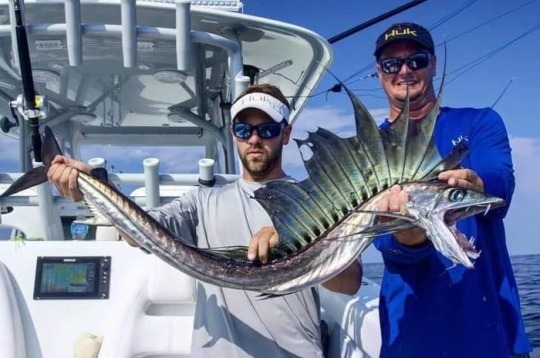
65K notes
·
View notes
Text
Hi there! My name is Iza! I'm really into speculative biology, aliens and world building! Is really like to meet more people with similar interests. If you could reblog this or interact somehow please do! I follow from this blog! Excited to make new friends.
#Xenobiology#speculative biology#speculative zoology#Alien#worldbuilding#speculative evolution#Ummmm hiii
0 notes
Text
I'm not pleased about the heat either, by the way. It's just jarring to watch everybody else desperately undress and look for the closest working air conditioning unit.
(I was provided with my own temperature sinkhole because I'm special.)
0 notes
Text
That being said, its crucial to try and mimic seasonal changes even in controlled environments. I wouldn't be able to explain in scientific details as I'm just a warrior and i don't know the ins and outs, whys and becauses of the science behind why they do what they do, but i can infer as a hunter that bodies get confused and sick when the seasons are all wonky.
Also we'd probably all go insane otherwise.
Hardship strengthens bonds. Everybody gets to complain about the temperature and the mission operator together as a group.
I've never been in a ship for longer than 3 cycles, and it seems like we'll be spending 2 cycles more. Roughly a seasonset. So I guess it's summer now!
0 notes
Text
It's barely 334J. Still, having dense winter fur doesn't help their case. It's about time to induce the molt, according to the captain.
Today the coolant systems are on decreased function for scheduled maintenance. It's always fun to watch my peers fur melt off their skin (non-literal). I'm fine. I get to hang in my tank.
2 notes
·
View notes
Text
Today the coolant systems are on decreased function for scheduled maintenance. It's always fun to watch my peers fur melt off their skin (non-literal). I'm fine. I get to hang in my tank.
2 notes
·
View notes
Text
((cannibalised this blog to put similar ocs in it. Everybody say hi to raptor.
1 note
·
View note
Text
I'll give it to you, we've been in the ship for roughly 2 cycles and it's still comfortable. Sanctities bless our commander is the matron's daughter! My old ships never had heated bathtubs. Seems like her little paws are deserving of luxuries such as warmth and comfort.
0 notes
Text
Public logbook and blogging entries kept by user_codename:"Raptor" under leadership of Commander-in-training Aelai.
All entries are automatically translated from jaapriole myridyan, please report any inconsistencies to the responsible authorities. The opinions displayed are not endorsed by the intersolar sigil and serve only as a secondary logbook and archival tool.
Alien blog by Iza, I'm 22!
|| PROFILES || RULES ||
0 notes
Text
This won't be particularly useful. I'm quite prone to rambling on, unfortunately (for her, I'm fine with this).
I'm a warrior, not a a sysop, so you'll all have to forgive me. Or rather! Put up with it. Nobody involved has a choice in the matter.
2 notes
·
View notes
Text
I suppose commander Aelai could do the logging, but she doesn't want to. I'm simply "yes ma'am'ing at her request of having the important stuff documented. Why me? Because.
I'm a warrior, not a a sysop, so you'll all have to forgive me. Or rather! Put up with it. Nobody involved has a choice in the matter.
2 notes
·
View notes
